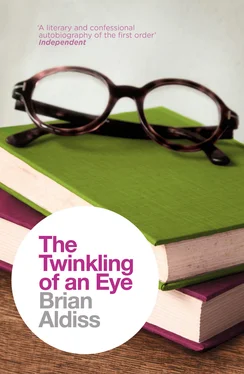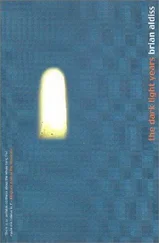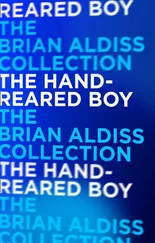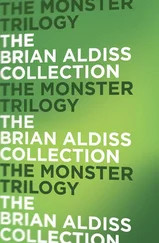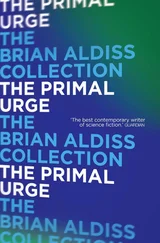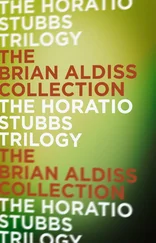For ever warm and still to be enjoy’d,
For ever drinking and for ever drunk …
I stand there, nose to the glass. Dot drags me home. But I can run upstairs to watch the display across the road. From our front window I get a good view.
They are still at it. The big red teapot is still dispensing its pretend Mazawattee. He still pretends to pour, and she to drink, pour and drink. The model works by electricity. But I think to myself that possibly Alice and the Mad Hatter have feelings: since they look human, perhaps they feel human. Perhaps they are forced to pour and drink, pour and drink – and all the while, smiling, they don’t wish to.
The existential dilemma overwhelms me. I cannot think my way out of the riddle. This enforced behaviour – all this enforced smiling – has wider and uncomfortable implications.
Of course I understand that this advertisement is simply a construct. But the incident of the cat torn apart ‘in the twinkling of an eye’ shows how narrow is the threshold between living and non-living things.
So supposing the figures are thirsty and want real drink while having pretend drink forced on them from that hideous red teapot …
And after all, we humans go on day by day, doing the same things automatically. Supposing we merely think we are real, the way Alice does in Hurn’s window. Suppose our feelings, like Dot’s, are insincere …
Are we stuck in a window with God outside, watching us go through the motions?
I am haunted by the Mazawattee Tea Paradox, Schrödinger’s Cat made flesh, or at least three-ply.
Dereham appears to be a God-fearing place. The religious habit in the late twenties and early thirties of the century is bound up with memories of the war, still fresh in people’s minds, and therefore with the social life of the country, and so with a patriotism that is now, at the end of our century, greatly diluted – probably for the better, the xenophobic element being also diluted.
In the United States, religion, or at least a frequent reference to the Almighty, is similarly bound up with social life, patriotism and big business (What’s good for God is good for General Motors). A kind of official optimism is also involved. Whereas in Britain the prevailing mood is more one of scepticism. It suits us better. The garment is cut according to the cloth.
This is well illustrated on Armistice Day, 11 November, commemorated with due ceremony.
The film is here an old documentary. For its viewers it is over in a few seconds; for those involved it is a caesura in their lives, rendered more weighty by that sense of time dragging its feet which important events engender. It is raining slightly. Dot puts on her cloche hat and her coat with the part-belt below her bottom. She scrutinises herself in a mirror before slipping a cachou into her mouth. Snowfire has already been applied to her chapped hands – the Snowfire pot bearing a brave image of a brazier of coals flaming away in the midst of an icy waste. She turns to her son and crams his arms into a small red mackintosh. We go downstairs. Taking up an umbrella from the stand in the porch, she leads the way to the market square.
Other people hurry in the same direction. All wear hats, the men with caps or soft felt hats or even bowlers, the women with various confections, some from H. H.’s millinery, their offspring perhaps in berets or ‘tammies’. Since I am only a little tacker, I also wear a tammy.
A considerable crowd has already gathered in the square. Uniforms, medals and banners are among them. People stand, solemn-faced, saying little. They are roofed by black umbrellas which make soft drumming noises as the rain falls on them. Everyone waits.
A silver band plays. Solemn marches and hymn tunes are the order of the day. At eleven o’clock, maroons sound.
Everything stops. Time itself dare not utter a word.
The men remove their hats or, if they forget to do so, have their hats knocked off. Heads are bowed. Traffic halts. In H. H.’s shop, customers and staff will remain in suspended animation for the Two Minutes Silence. All over England and Wales and Scotland and Northern Ireland, the United Kingdom, silence prevails. A silence of mourning and thanksgiving.
The maroons sound again. Once more, normal lay life resumes. Hats go back on heads. The inhabitants of East Dereham close their umbrellas, shake them, and return to work.
‘Mummy, what are you supposed to be thinking in the Silence?’
‘You can thank God that your father survived the War.’
But if he had been killed, I begin to think, then I …
The church in Dereham is dedicated to St Nicholas. In the middle of the nineteenth century, its benevolent vicar was Benjamin Armstrong, extracts from whose diaries have been published. But of greater interest to the world of letters is the smaller church in the market square, squeezed between two shops. It is as ugly as if built by Thomas Hardy in his architectural phase. Its ugliness proclaims that no beauty has meaning, except the beauty of God (see inside). One cannot think that any Eastern religion would embody in stone such an absurd thought.
This is our church. It commemorates the poet William Cowper, who died in East Dereham in the year 1800. We are Congregationalists. If the documentary film is left running, it will catch us every Sunday entering this place of worship, Bill, Dot and Brian, in their Sunday best. We are greeted by our vicar, a small lively woman, Edna V. Rowlingson.
Our pew is at the rear of the church, on the left as you go in. The Guv’ner will be here. Also, in the pew just in front, Gordon’s family, his sharp-nosed wife, Dorothy (née Childs), and their three children, Joyce, Derek and Tony. Not Gordon. Gordon is the organist. The Guv’ner will read the first lesson. Bill is ‘linesman’ with Mr Fox, and will move down one of the two aisles, taking the collection in a shallow wooden plate. The Aldisses really have religion buttoned up.
The interior of the church is different from anything else I know at that time. Not comfortable, with the seedy brown-sugar comfort of the Exchange Cinema, rather echoing voids and dumb surfaces, the solidity of pillars either being or resembling marble. The pulpit, into which our little reverend climbs to preach to us, is of the stoniest stone.
Miss Rowlingson is not shy. She speaks forthrightly, never forgetting she has children in her audience. All the same, we children are sinners like the rest of the congregation. Hell fire awaits us too. Oh, she’s convincing, with that terrible inarguable faith also resembling marble. For years and years to come, I shall wonder, Is it true? The first lie, the first wank, the first shag in Calcutta: Is it true about hell fire? Am I to suffer eternal damnation?
To capture the attention of her congregation, the Revd Rowlingson leads into her terrible themes with the beginnings of an interesting story. She might open the sermon by saying, ‘Last week, I decided to go into the country. I was walking in the fields near Swanton Morley, when suddenly I saw I was in a meadow with a large bull. The bull began to approach me from the far side of the field at an increasing pace. Temptation is rather like that bull …’ We are back with damnation, which may gore us at any moment.
A scarcely audible sigh of disappointment escapes the children in the congregation. There are three characters in this fragment of story, the person, the bull, and God. Of these three, God is the least interesting. We don’t know what the person and the bull may do, but God has made his position perfectly plain.
The bull has more options than God. He can charge at Edna and toss her, he can charge and funk it at the last moment, or he can simply walk about looking slightly down in the mouth, in the manner of English bulls.
Читать дальше
